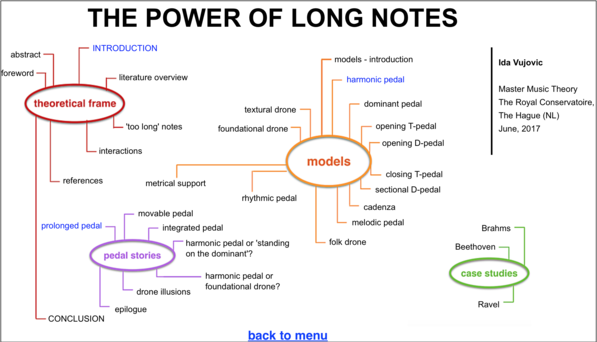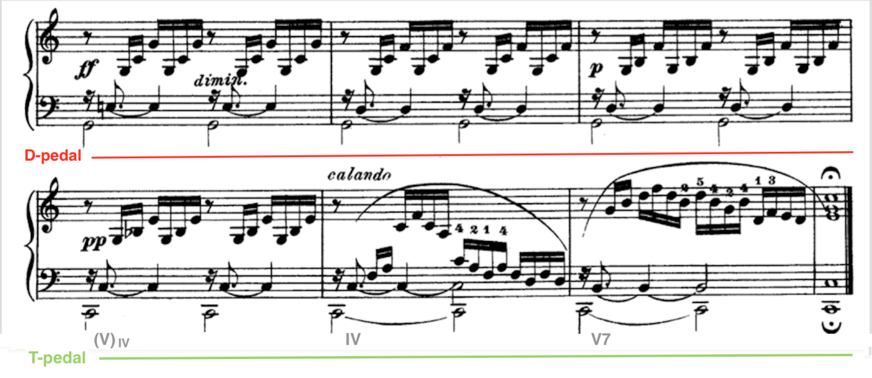Closing Tonic Pedal
For Meyer, completeness is a basic psychological need: "... incompleteness gives rise to expectations of completeness. […] Our opinion or feeling as to the completeness of a given stimulus is a product of the natural modes of mental organization." (1956: 128) When a piece is complex, or relatively extended, or where there is a lot of tension close to the end of the piece, simple tonic chord at end could feel as insufficiently closing. The good balance of tensions and relaxations within a piece could need a ‘discharge’ section, the section where the felt energy will decrease, so that a dynamic completeness could be felt. A closing T-pedal is, both as a process and as a model, efficient actor toward reaching this goal.
The tonic pedal at the end of a tonal piece usually forms a tonic prolongation, a final confirmation of the home key and its tonic. Above it, there could be any sort of reminiscence of the past events, such as important motifs. A usual harmonic pattern is what Robert Gjerdingen (2007: 181-196) calls Quiescenza: I - (V)IV - IV - V - I. This model was very popular at the end of the 18th century in Vienna. The word quiescenza (It.) refers to a state of repose or inactivity, and Gjerdingen explains that: ”Just as a cadenza exploits a pause within an important cadence to show off the performer’s taste, invention, and virtuosity, bringing the forward progress of the movement temporarily to a halt as a result, so a Quiescenza exploits a moment of quiescence following an important cadence, likewise holding back the further progress of the movement or delaying its ultimate close.” (p.183)
As shown in the previous example, the chord progression above the pedal can start directly from (V)IV. In such case, the resolution of the dominant pedal is not instant; it is a process, in which the ‘clean’ tonic will arrive only at the end.In this particular case, the omission of the ‘clean’ tonic at the arrival of the T-pedal is a part of a longer closing section that begins even before the last seven bars shown here (see the full score within Pedal Story ‘Prolonged Pedal’). The very long dominant pedal has accumulated a lot of energy, which must be balanced with a powerful tonic. The power could come from its duration (a long tonic) or its ‘content’. In this case, the (V)IV is both confirmation and denial of the expectations related to the resolution of the dominant. It transforms one part of the accumulated energy into the satisfaction related to the confirmation, and the other part into the new expectation-tension, related to the expected IV. If the listener recognizes the closing T-pedal model, the expectation that everything will go according to Quiescenza model is paired with the belief that these bars will close the piece (or a larger section). With each confirmation, related to the succession of the chords, the belief that no excitements are awaiting us is getting stronger and the tension drops.
The following example shows the small coda at the end of the theme of Haydn’s Divertimento St.Anthony chorale. In this case, the T-pedal starts in the final cadence of a rounded binary form. One could see the necessity for such a coda in the proportions of the structure. The opening a section is a period of 5+5 bars. The contrasting b section is a phrase of 8 bars. The closing a repeats only the consequent of the opening period, which might feel being too short. The small coda groups with the last section (could be seen as an expansion of the cadence), ‘correcting’ the proportions.
The analysis does not show any dominant harmony above the pedal (the progression is essentially plagal). There is, though a hint of a closure at the end of its second and fourth bar (the leap into the C in Fg. part).
Closing T-pedal combines the harmonic tension with the feeling that the resolution has already taken place, and that this section is just prolonging the final chord. The harmonic tension in the listener’s musical ear is therefore not intensified, but rather decreased. This tension is ‘sweet’ because we have already arrived. A part of pleasure is a result of the contrast between the local tension (harmonic), and the global relaxation. ‘Knowing that it is the end’ is integrated in this pedal-model.
When the listener is not sure that the piece is in its final phase - while she feels the possibility that it is - hearing a T-pedal could make her interpret the current structural location as being the closing section. Beethoven’s bagatelle op.33 no. 6 in D major illustrates this. The ternary structure A B A1 consists of the following smaller units:
There is only one basic idea (theme), harmonically very simple, recurring. The first contrasting section b derives its material from a. The middle part c is very short, also based on the same basic melodic idea (the key is instable). Minor keys prevail, which provides the contrast. In the reprise (A1), the opening phrase repeats in a varied form: the notes of the theme are ‘hidden’ in many ornamenting sixteenths. When the original baa’ returns, its relative simplicity could be felt as a closing gesture on the higher structural level. In the performance of three-part forms (such as Minuet and Trio) the return of the first compound section (A1) is sometimes performed without repetition of baa’ at end. In the case of the bagatelle op.33 this could be a reasonable decision (after this much similar material) - had Beethoven written the repeat barlines. However, Beethoven decides to vary this section, and thus possibly with a bit of surprise, the listener hears b1a1a1’. The long closing pedal is needed to make sure that nothing else should be expected. The closural power of T-pedal after all the material is exposed, is used here to announce and prepare for the end.
A long ‘exhaling’ tonic at the end of an exciting piece is not necessarily a pedal; it could be just a long tonic. Closing T-pedal always underlines some story; it always accompanies some events that also need to come to closure. Pedal Story 'Harmonic Pedal Or 'Standing On The Dominant'?' (about Bruckner’s 7th symphony) reflects on this issue.
next: Sectional Dominant Pedal or return to menu




